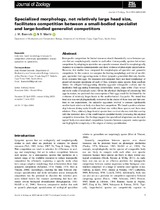| dc.contributor.author | Barends, Jody, M | |
| dc.contributor.author | Maritz, Bryan | |
| dc.date.accessioned | 2021-09-30T10:46:18Z | |
| dc.date.available | 2021-09-30T10:46:18Z | |
| dc.date.issued | 2021 | |
| dc.identifier.citation | Barends, Jody & Maritz, Bryan. (2021). Specialized morphology, not relatively large head size, facilitates competition between a small-bodied specialist and large-bodied generalist competitors. Journal of Zoology. https://doi.org/10.1111/jzo.12914 | en_US |
| dc.identifier.uri | doi:10.1111/jzo.12914 | |
| dc.identifier.uri | http://hdl.handle.net/10566/6839 | |
| dc.description.abstract | Interspecific competition for limited resources should theoretically occur between species that are morphologically similar to each other. Consequently, species that reduce competition by adapting to specialize on a specific resource should be morphologically disparate to sympatric contemporaries and show evidence of phenotypic specialization. However, few studies have compared the morphologies of specialist and generalist competitors. In this context, we compare the feeding morphology and diet of an obligate, specialist, bird-egg-eating snake to three sympatric generalists that only facultatively consume bird eggs. We measured and compared body and head morphology of preserved museum specimens of each of four, syntopic snake species from southern Africa: the obligate bird-egg-eating rhombic egg-eater (Dasypeltis scabra), and the facultative bird-egg-eating boomslang (Dispholidus typus), cape cobra (Naja nivea) and mole snake (Pseudaspis cana). Given the physical challenges of consuming bird eggs in snakes, we predicted that consumption of bird eggs would be facilitated by the evolution of relatively larger heads in the smaller bodied Dasypeltis. We found that head size was not phylogenetically conserved in the clades of these taxa and that contrary to our expectations, the specialist egg-eaters evolved to possess significantly smaller heads relative to body size than their competitors. We found a positive relationship between dietary niche breadth and head size within these species and their close relatives. Thus, relatively large-headed species have evolved diverse diets that overlap with the restricted diets of the small-headed specialist thereby producing this atypical competitive interaction. Our findings suggest that specialized adaptations can decouple typical body-size-constrained competition dynamics between sympatric snake species and highlight the complexity of the origins of dietary specialization. | en_US |
| dc.language.iso | en | en_US |
| dc.publisher | Journal of Zoology | en_US |
| dc.subject | Body size | en_US |
| dc.subject | Head morphology | en_US |
| dc.subject | Interspecific competition | en_US |
| dc.subject | Phenotypic specialization | en_US |
| dc.subject | Snakes | en_US |
| dc.subject | Specialists vs. generalists | en_US |
| dc.title | Specialized morphology, not relatively large head size, facilitates competition between a small-bodied specialist and large-bodied generalist competitors | en_US |
| dc.type | Article | en_US |

